Abstract
When solar panels reach end-of-life, the disposal of solar panel waste is an issue of concern because it creates environmental pollution if it is improperly disposed of. It is expected that such waste will probably be increasing as the widespread use of renewable energy is adopted by taking measures associated with carbon neutrality. Thus, accurate prediction of solar panel waste with future demands for renewable energy is urgently needed for sustainable waste management. This study examined the amounts of solar panels to be retried by 2050 under three scenarios (S1-BAU, S2, S3). The amounts of solar panels to be retired are estimated by using the PBM (population balance model) with the Weibull distribution. According to the carbon neutral scenario (S3), the total amounts of solar panels to be retired are anticipated to be around 172 kt in 2030, 932 kt in 2040, and 3146 kt in 2050. The total volume of retired solar panels was projected to be 168 kt in 2030, 820 kt in 2040, and 2331 kt in 2050 under the government-led scenario (S2). The average recovery of end-of-life solar panels produced by the three scenarios in 2050 is 1531 kt, 337 kt, 535 kt, and 22 kt for glass, aluminum, silicon, and copper, respectively. Economic benefits by resource recovery of retired solar panels in 2050 range from $25.6 million in S1 to $519.1 million in S3. Based on the sensitivity analysis with the weight of solar panel (5% and 10% reduction), the results indicated that the annual volumes of retired solar panels mostly fell within the range of 4.9% to 10.0% in 2050. To confirm the predicted volumes of retired solar panels in this study, a further study is warranted because they can be influenced by other factors (e.g., weight, technology development, early loss rate, or reuse and recycling options).
1. Introduction
Carbon neutrality has emerged as a new global agenda following the Paris Agreement [1] and the UN Climate Summit [2]. Because of the increased awareness of the seriousness of climate change, major countries such as the EU, China, Japan, and the United States have accelerated the declaration of carbon neutrality [3]. This is a shift in global regulations and management activities to actively respond to climate change. Prior to and following the declaration of carbon neutrality, the EU and the US announced large-scale green investments [4,5]. The EU plans to boost the share of renewable energy to 32% by 2030, and the US to 44% by 2050, in order to minimize GHG emissions [6,7]. One of the many acknowledged renewable energy sources that is both sustainable and friendly to the environment is solar energy [8]. Globally installed solar power capacity is anticipated to reach 6862 GW by 2050, making up 60% of the 11,454 GW installed capacity for all renewable energy sources [9].
According to the Korea Green New Deal, the target for solar power installations in 2025 will be raised from 21.4 GW to 33.5 GW in the 9th electricity supply and demand plan, which was announced in December 2020 [10]. If the Green New Deal trend continues, total solar power installations in 2034 will be 68.8 GW [11]. The upper limit of the supply duty ratio under the mandatory supply of new and renewable energy was raised from 10% to 25% of the existing total electricity production in April 2021, as part of the revised bill of the “Renewable Energy and Renewable Energy Development, Use, and Dissemination Promotion Act” [12]. This is a transition plan for further reducing greenhouse gas emissions, with the goal of accelerating investment in new and renewable energy for the transition to a low-carbon economy and society.
Under the Waste Electrical and Electronic Equipment (WEEE) Directive, the EU required member states to recycle solar panels; in response, Germany, the UK, and other countries enacted domestic rules based on WEEE that were specific to their respective situations. The recycling target is 80% of collected waste modules, and the collection target is 65% of the three-year average market supply or 85% of created waste (by weight). States in the US are passing legislation pertaining to the recycling of solar panels. Among these, Senate Bill 5939, passed in 2017, allows the Washington State Legislature to run a solar module management and recovery program. Australia, China, and Japan do not have laws requiring for the recycling of retired solar panels.
In Korea, retired solar panels are managed by the extended producer responsibility (EPR) in the beginning of 2023 regulated by the Act on Resource Recycling of Electrical and Electronic Equipment and Vehicles [12]. By the regulation, producers (i.e., manufacturers and importers) are required to recycle at least 80% of the collected waste panels for material recovery. The producers annually contribute the recycling costs of the solar panels to support recycling industry. There are five regional collection centers for retired solar panels and electric battery around the country. The “All-baro System” has been used to track retired solar panels discharging more than 5 tons, and starting in January 2023.
1.1. Literature Review
With less reliance on fossil fuels like coal, oil, and natural gas, greenhouse gas emissions may be decreased as a result of the rise in renewable energy. On the other hand, panels that are disposed after their useful lives can contaminate the environment even more. The act of burying or discarding retired panels carries a danger of environmental pollution, since it may leak heavy metals like cadmium, lead, and chromium [9]. As the usage of new and renewable energy increases, solar panel production is anticipated to develop quickly. Even after solar panels reach the end of their useful lives, waste solar panels will continue to rise. Scientific research on precise projections of future solar panel disposal is currently lacking, despite the significance of recovering resources from waste and preventing pollution.
Reduced panel weight and longer panel life expectancy were two parameters taken into account in Lim’s study [13] to anticipate the quantity of retired panels. Kim et al. [14] projected waste under the assumption that waste module discharge characteristics and solar module lifespans are regularly distributed. Three lifespan models (damage and technical failure, power decline, and economic motive) are presented by Tan et al. [15] and are based on a range of sources, such as government agencies, other policy makers, regulators and consultants, energy suppliers, researchers, recyclers, and manufacturers. estimated the quantity of solar panels that Australia would discard. Peeters et al. [16] analyzed the material composition of retired silicon-based photovoltaic (PV) panels in the Flanders region of Belgium by consulting experts and analyzing the volume of retired panels collected through the European collection program. Zang et al. [17] developed six scenarios to estimate the quantity of wasted solar panels in China while taking into account parameters including solar panel quality, operation and maintenance, and failure modes. The geographical and spatial distribution of PV waste in China from 2020 to 2050 was estimated by Wang et al. [18] using a two-stage multi-criteria method coupled with material flow analysis for 44 scenarios with varying PV deployment scales, growth rates, and spatial reduction criteria.
Determining the amount of retired solar panels is essential for efficient recycling, waste treatment and management. In this work, we provide a numerical approximation of the waste production based on supply capacity scenarios for solar panels with a lifespan distribution. The estimate’s potential for resource recovery was also evaluated.
The weight of solar panel supply and lifespan both have an impact on the quantity of discarded panels. To estimate the quantity of retired solar panels produced in Korea, a number of earlier research have been carried out [9,13,19,20,21,22]. Average weight and lifespan of the panels are input variables used to estimate the quantity of retired panels produced. In the most researches, the lifespan and average weight values of solar panels were assessed by dividing them into portions according to the year of installation [13,21,22]. Previous studies have evaluated single values of lifespan or average weight [9,19,20]. The life expectancy ranged from 19.5 to 25 years, with the lifespan being determined differently based on the year of installation [9,19,21,22].
In overseas research shows that the lifespans of the solar panels were assumed to be 25 to 30 years [23,24], which is typically the length of time that the panel manufacturers provide warranty periods. Padoan et al. [23] reported that the amount of solar panel waste generation under the loss scenarios was calculated using an average panel lifespan of 26 to 28 years. However, according to Murakami et al. [25] shows that solar panels could be utilized up to 57 years before needing replacement, while the panel’s lifespan can be increased by up to 40 years by adjusting the temperature [26]. Solar panel will therefore probably last longer than their guarantee. Jo et al. [9] assumed to be retired after panels reach the end of their lives. Korea Environment Corporation [22] made the assumption that some of the panels could be repowered and reused. Panels with a lifespan, however, typically have a probability distribution. When it comes to evaluating lifespan data, the Weibull distribution is more reliable than other statistical methods for analyzing lifetime data [27]. The Weibull distribution, a format for distribution used to probabilistically characterize a product’s life, was created on the premise that a product’s failure rate is expressed as a function of time [27]. The International Renewable Energy Agency (IRENA) and the International Energy Agency’s Solar Power Systems Program (IEA-PVPS) estimated waste volumes using the Weibull distribution in both early and regular loss scenarios [28]. In a subsequent research, same Weibull distribution approach was used to predict solar panel waste generation in China, Belgium, Australia, Spain, and Korea [29,30,31,32,33]. In Kim and Park’s analysis, the yearly supply quantity of solar energy needed to meet the government’s 36.5 GW target for solar power supply by 2030 was expected to vary for each scenarios [33]. Furthermore, a conservative assumption was made that the supply will remain at 36.5 GW after 2030. Life expectancy was estimated to be 25 to 30 years in the early and regular loss scenarios.
When it comes to solar panel supply, the weight of solar panels is also trending downward as a result of scientific and technological breakthroughs, The average weight was estimated to be a single kilo per kW in previous studies on solar panel waste prediction carried out in Korea; however, in most recent researches, the average weight was divided into parts to forecast the volume of the retired solar panels.
1.2. Novelty and Contribution
The novelty of this paper is that it divides the weight of the solar panels onto parts and uses that information to anticipate the number of the retired solar panels with lifespan distribution based on the supply scenarios through 2050. It will give more accurate figures for solar panel recycling and management in the future by allowing comparisons of the quantity of waste generated based on supply scenarios.
This work makes several significant contributions: it provides an overview and forecast of Korea’s PV installed capacity using three scenarios; it uses Weibull distribution-based estimation methodology; it compares IRENA research, domestic research and estimated estimates of waste panel generation in 2030 and 2050; it predicts recoverable metal amount using retired solar panel metal recycling yield; it evaluates recycling economically; it analyzes sensitivity to changes in solar panel weight; and it includes cumulative estimates of solar waste retired panels generated in South Korea by scenario by 2050.
The present study is designed to accomplish the aforementioned research aims. In Section 2, the scope of the analysis is defined, a technique for calculating PV waste generation is chosen, and specified the parameters and underlying presumptions of the employed methodology. The findings are shown in Section 3 along with possible ramifications. The findings and restrictions of this investigation are detailed in Section 4.
2. Methodology
2.1. Data Acquisition
The Korea Energy Agency’s data was used to compile the supply of solar capacity. It used three scenarios to calculate the capacity of solar electricity generation until 2050, based on actual statistical data up until 2020 [34]. Another input variable that was used to determine the average weight of solar panels by year of supply was the Korea Environment Corporation value [22], which is displayed in Table 1. But after 2030, the panel weight is anticipated to keep falling, reaching 40 kg/kW, based on the Korea Environment Corporation’s research methodology.

Table 1.
Average weights of solar panels in South Korea.
2.2. Scenario Analysis
The capacity of solar energy supply was predicted using three different scenarios. The first scenario, S1, is based on the assumption that by 2050, the average supply capacity of solar energy from 2017 to 2021 was applied as constant. In the second scenario (S2), the Korea government’s renewable energy plan was employed. According to the government’s policy for managing power supply and demand, it is projected that installed capacity grows by 5% annually [10]. The largest renewable energy supply scenario (S3) assumes that carbon neutrality is accelerated and achieved in 2050, and that supply capacity would rise by 10% annually. The quantities of solar panel to be retired was estimated between 2030 and 2050 using these three scenarios (S1, S2, and S3).
2.3. Estimation Model
This study’s estimation method is based on the Population Balance Model (PBM), which is one method for calculating the amount of WEEE generated [35]. Products are introduced to the market, and after a certain period of use, when their value reaches an irreversible level, they are discarded as waste. The difference in input and output amounts remains in the system, and this series of product flow phenomena is arrayed as a balance model. The following equations describes the generation of products to be retired [35]:
where ft (i) is the disposal rate, which is the proportion of i-year products that reached the end of their useful life in year t.
where Nt represents the number of products in stock at the end of year t. Pt refers to the number of products produced in year t. Gt is the amount of waste generated by solar panels.
2.4. Lifespan Prediction Ssing Weibull Distribution
The Weibull distribution can be used to forecast the cumulative failure rate of solar modules. And the equation is given below.
The time in years is denoted by t, the average lifespan is denoted by T, and the shape factor is denoted by α. The shape factor governs the Weibull curve’s usual S shape. The shape factor value ranges from 2.49 to 14.4, according to several references [30,36,37,38,39]. The alpha shape factor value for the early loss scenario was 2.49, whereas the value for the regular loss scenario was 5.38 [25,32]. A lower shape factor indicates a higher risk of failing in the early stages of life. A larger shape factor indicates a greater concentration of failures around the typical lifetime [32]. This analysis used an early loss scenario (e.g., broken parts, mismatch between the solar modules), assuming that 0.5% of solar panels will be retired within 2 years, 2% within 10 years, and 4% within 15 years.
3. Results and Discussion
3.1. Current PV Installation Trend
Using statistics on the supply of new and renewable energy provided by the Korea Energy Agency, the supply status of solar power generation facilities in Korea was summarized in Figure 1 [34]. Korea started producing solar energy in 2004, and since 2006, thanks to initiatives like the Renewable Energy Portfolio Standard (RPS) and the feed-in tariff (FIT) program, solar power generation has considerably increased. A total of 500 MW worth of solar power producing facilities for commercial use were supplied through the domestic FIT program between 2005 and 2011. Among them, 244 MW or so was supplied in 2008, a significant increase from previous years. From 2010, the domestic RPS system started supplying commercial solar power producing facilities. From 2018, a sharp rise in supply has been seen as a result of the government’s “Energy 3020 Implementation Plan”, which was announced at the end of 2017.

Figure 1.
Annual solar energy production of Korea [34].
Figure 2 shows how the growth in solar power generation has rapidly increased since 2012. The cumulative supply was roughly 22 GW, and the new supply in 2021 was about 4.4 GW. Over the period of four years (2018~2021), new solar power installations were more than 2.4 times the total installed capacity of solar power in 2017. This suggests that solar power supply has been accelerating in recent years, although in 2021 the decrease of the supply was observed partly due to economic depression during COVID-19.
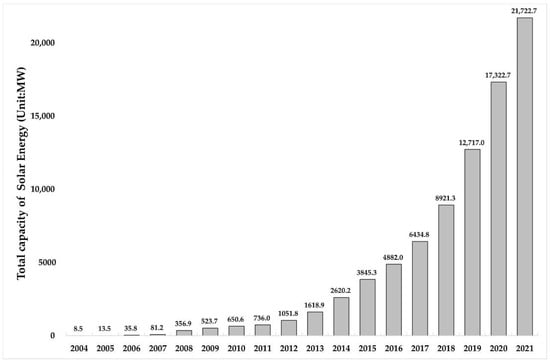
Figure 2.
Total capacity of Korea’s solar energy production.
As of 2020, almost 66% of the world’s new solar power markets was occupied in China, the United States, Vietnam, Japan, and Germany [40]. Among these countries, China, the United States, Japan, and Germany are the top four nations in terms of total solar power generation capacity. The annual PV supplies for the four nations and Korea are shown in Figure 3.
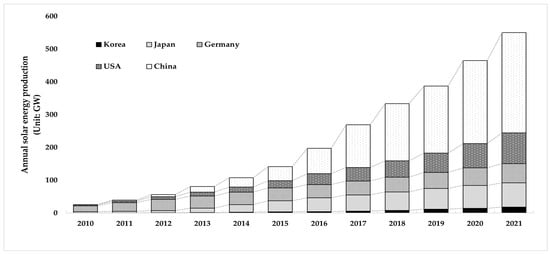
Figure 3.
Annual solar energy production by nation [41].
Germany topped the new solar energy supply from 2007 to 2014, followed by China, Japan, and the United States. From 2015, China supplied 77 GW of solar energy, taking the top spot by a majority and keeping hold of the indisputable top spot. Germany, Japan, and the United States had a different ranking from 2015 to 2019, and in 2019 the order was altered to the United States, Japan, and Germany. In 2020, Korea will have a supply capacity that is only 25% that of Germany. As shown in Figure 4, Germany is the most developed nation in the solar power industry and has held the top spot in terms of solar energy generation for a very long time. China, however, took the top rank, while Germany’s capacity for solar energy has already been exhausted and fresh investment is declining. China has been supplying solar power producing facilities at a higher rate since 2017, as shown in Figure 4. The gap between Korea and the four nations has kept increasing by 2021, ranging from at least 2.2 times to 16.8 times.
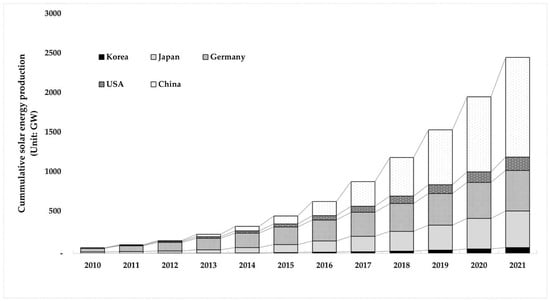
Figure 4.
Cumulative solar energy production by nation [41].
3.2. Projection of PV Installation Volume Using Scenarios
Three alternative scenarios were considered in this study to determine the installed solar capacity. Figure 5 displays the anticipated yearly PV supply (MW) for each scenario from 2025 to 2050. It can be noted that it has a similar value to the anticipated capacity of S1 and S2 in 2025 when compared to the cumulative capacity of 36.5 GW predicted in the 10th Power Supply and Demand Plan for that year. Up until 2030, there is little difference between the three scenarios in the capacity of solar energy supply. However, it was discovered that S3 grew from 3.14 to 6.2 times while S2 varied from S1 by 1.9 to 2.6 times between 2040 and 2050.

Figure 5.
Projected solar energy capacity by scenario.
The generated panel of solar power is shown in Figure 6 by multiplying the expected total solar supply capacity by the panel weight tons per MW. The S1 graph in Figure 6 does not appear to be increasing significantly, it is anticipated that technological advancement would reduce solar panel weight from 88 ton/MW to 40 ton/MW while maintaining the newly installed capacity.
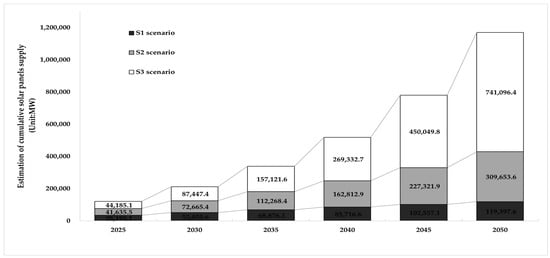
Figure 6.
Estimation of cumulative solar panels supply by scenario.
3.3. Estimation of Retired PV Modules
For each of the three scenarios, the Weibull distribution was used to calculate the retired solar panels yield for the early loss scenario. The shape factor in this paper is 2.4. As illustrated in Figure 7, each of the three scenarios is anticipated to result in an average weight of 20 kt, 21 kt, and 22 kt of solar waste panels between 2025 and 2030. Based on S1, S2 and S3 revealed an annual average difference in waste volume of 52 kt and 118 kt, respectively, between 2040 and 2050. S3 in particular exhibits a significant change when compared to S1 from 2035, ranging from 140 to 286 percent. Except for 2025 and 2030, the remaining values revealed values that were comparable to S1 when compared to data from domestic research [13]. It appears that the early loss scenario used in this paper made its value is higher than the comparable data for 2025 and 2030.
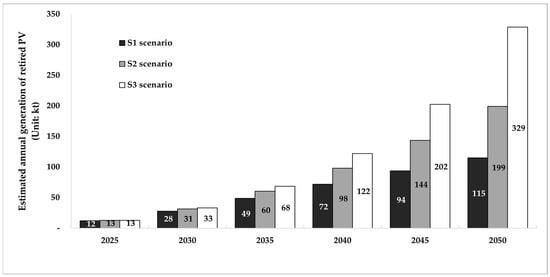
Figure 7.
Estimated annual generation of retired PV by scenario.
In all scenarios, the total quantity of retired solar panel appears to be more than triple the total output in 2030 compared to 2025. According to Figure 8, the exponentially increase is observed and it would continually increase by 1.4 to 2.5 times starting in 2035, depending on the scenario. This implies that starting in 2035, solar panel retirement will start in earnest.
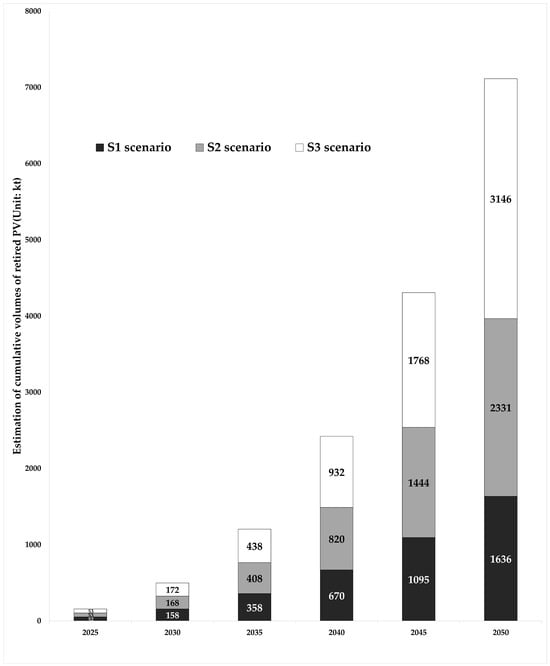
Figure 8.
Estimation of cumulative volumes of retired PV by scenario.
To verify the accuracy of our anticipated values, we compared them with IRENA data [25] and previous researches in Korea [13,22]. The Korean data from the IRENA report are located between the S1 and S2 levels of this study, as shown in Table 2. It is considered that similar values were obtained when comparing only the data using the early loss scenario through the Weibull distribution, even if the photovoltaic market share, weight, and lifespan of the solar panel are different in the IRENA study. The discrepancy between this paper and results of Lim & Korea Environment Corporation from different presumptions used. It was therefore disregarded when comparing it to this study. Instead, the forecasted volumes of foreign waste panels in the IRENA report in 2030 were normalized by each country’s area and projected population [42,43,44,45,46] in order to allow for a relative comparison of the predicted volume of this paper. When the quantity of waste produced in each nation in 2030 is divided by its area, Japan and Germany, which are roughly three times larger than Korea, show 2646 kg/km2 and 2796 kg/km2, respectively, whereas Korea’s solar panel waste generation in scenario 2 is 1673 kg/km2. In contrast to Korea’s 3 kg/person, production rates of solar panel waste were estimated to be 8 kg/person for Japan and 12 kg/person for Germany, based on the projected population in 2030. Given that the supply volume was higher than that of Korea between 2005 and 2010, it seems that this displayed a higher value than Korea. Korea was found to generate more waste per unit area (23,215 kg/km2) in 2050 than any other country. Furthermore, after Japan (147 kg/person), the estimated amount of waste per population was the second largest at 54 kg/person.

Table 2.
Comparison of predicted cumulative generation of retired solar panels with other countries (unit: kt).
3.4. Resource Recovery Potentials by Recycling of Retired Solar Panels and Cost Analysis
The majority of the discarded solar panels will be made of crystalline silicon [47]. Glass (approximately 68% by weight), aluminum (about 15% by weight), high-purity silicon (about 3% by weight), and copper wires (about 1% by weight) make up the majority of the recyclable components in PV panels [48]. Figure 9 illustrates the estimated recovery of glass, silicon, copper, and aluminum under the assumption that 95% of the valuables in PV panels are recovered by scenario. The average recovery of end-of-life solar panels produced by the three scenarios in 2050 is 1531 kt, 337 kt, 535 kt, and 22 kt for glass, aluminum, silicon, and copper, respectively. Assuming a value of 267.2 won/kg is produced when recycling 1 kg of used solar panels [49], recycling income estimates for 2050 range from $25.6 million in the S1 scenario to $44.3 million in the S2 scenario to $519.1 million in the S3 scenario.
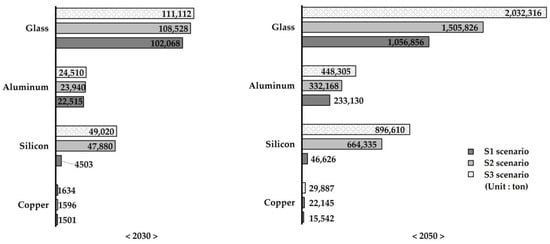
Figure 9.
Resource recovery potentials from retired PV in 2030 and 2050 by scenario.
To determine the impact of the panel’s weight on the volume of waste solar panels, a sensitivity analysis was carried out. The quantity of waste was examined in the 5% and 10% weight reduction scenarios for solar panels.
As shown in Figure 10a, by 2035, the waste volume is projected to fall proportionately in all scenarios. The annual waste reduction in the S1 and S2 scenarios, however, increasingly diverged starting in 2035. On the other hand, the amount of waste was rapidly increased in the S3 scenario with accelerated supply capacity. It was observed that the difference in reduction caused by the change in the weight of the solar panel was not significant. In the cumulative waste quantity in Figure 10b, the S2 scenario’s amount of waste in 2050 varied from that of the other scenarios depending on how much the weight of solar panels was reduced. Other factors to be taken into account when estimating the amount of waste generated by solar panels may include the manufacturing process, recycling rate, end-of-life management, climate, and environmental considerations.
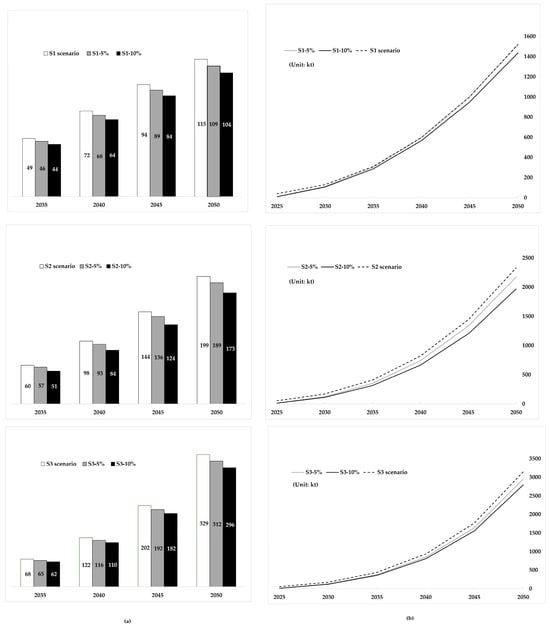
Figure 10.
Annual (a) and cumulative (b) volumes of retired PV by sensitivity analysis.
4. Conclusions
Renewable energy is becoming prevalent as the global efforts on low-carbon activities toward a carbon neutrality society. Solar-powered renewable energy supplies in particular have been rapidly growing. In the coming years, it is anticipated that the generation of waste solar panels would continually increase, once they reach end-of-life. Quantitative analysis for such waste is needed for resource recovery and proper waste management by adopting cost-effective recycling technologies. In this paper, the amounts of retired solar panels were evaluated by scenario analysis (S1-BAU scenario, S2-the government’s renewable energy plan scenario, and S3-carbon neutral scenario).
Due to Korea’s delayed adoption of solar energy, retired solar panels will be retarded, later than in other nations. Based on the supply capacity of solar energy, the amount of retired solar panels in 2021 is 0.736 tons/MW. It is anticipated to rise considerably to 3.04 tons/MW for S1, 2.31 tons/MW for S2, and 1.97 tons/MW for S3 in 2030. In comparison to supply capacity of the solar energy, S1 would generate the most retired panels because of the cumulative supply capacity as denominator (MW) is relatively smaller.
Upon conducting a comparative analysis with the IRENA study [25], it was discovered that the predicted value of the S2 were very similar to their forecasted amounts. However, our estimated numbers somewhat differ from other two studies [13,22]. The reason why the difference occurs is due to different input variables, such as the panel’s weight and lifespan. In addition, this research was conducted by a dynamic flow analysis, based on lifespans, while the previous studies heavily relied on the models with a linear or normal distribution on the lifespan. We also assessed resource recovery potential of the retired panels based on resource recycling yield and the reduction of the environmental contamination resulting from retired panels’ landfilling. This will make it feasible to calculate the capacity needed for constructing infrastructure for the recycling of the retired solar panels. Furthermore, an assessment was conducted on the potential economic benefits by recycling retired solar panels.
Further investigation is still required to validate the scenario models used in this work. Projected quantities of retired solar panels can be compared with actual retired data in the future once they reach end-of-life. Periodical updates and analysis may be required for the accuracy of our scenario models to be validated. One of the study’s limitations is that the proportions of recycling and reuse in retired solar panels were not taken into account. Lastly, more research is also necessary because the quantity of solar panels that need to be disposed of might differ significantly from actual conditions, depending on a number of parameters (e.g., the material composition, weight, lifespan of solar panels, national renewable energy goals and regulations, and future technical advancements).
Author Contributions
S.-H.L. collected basic data for the analysis and compared the data with those of other countries, prepared for the basic survey related to energy supply plans, and conducted the PBM analysis. Y.-C.J., corresponding author, developed the theoretical formalism, provided the PBM methodology and calculations. All authors have read and agreed to the published version of the manuscript.
Funding
This research received no external funding.
Data Availability Statement
Data are contained within the article.
Acknowledgments
This work was supported by Korea Ministry of Environment (Korea MOE) as Waste to Energy Recycling Human Resource Development Project.
Conflicts of Interest
Author Su-Hee Lee was employed by the company Central Research Institute, Korea Hydro & Nuclear Power Co., Ltd. The remaining authors declare that the research was conducted in the absence of any commercial or financial relationships that could be construed as a potential conflict of interest.
References
- United Nations. Paris Agreement. 2020. Available online: https://www.un.org/sg/en/content/sg/articles/2020-12-11/carbon-neutrality-2050-the-world%E2%80%99s-most-urgent-mission (accessed on 29 August 2023).
- Climate Action Summit. 2019. Available online: https://www.un.org/en/climatechange/2019-climate-action-summit (accessed on 29 April 2023).
- Chatham House. China, EU and US Cooperation on Climate and Energy. 2021. Available online: https://www.chathamhouse.org/2021/03/china-eu-and-us-cooperation-climate-and-energy (accessed on 29 August 2023).
- European Commission. The European Green Deal. 2019. Available online: https://ec.europa.eu/commission/presscorner/detail/en/ip_19_6691 (accessed on 29 April 2023).
- IMF. A New Vision for the US Climate Agenda. 2021. Available online: https://www.imf.org/en/Blogs/Articles/2021/03/10/blog-a-new-vision-for-the-us-climate-agenda (accessed on 29 April 2023).
- European Council. “Fit for 55”: Council Agrees on Higher Targets for Renewables and Energy Efficiency—Consilium. 2022. Available online: https://www.consilium.europa.eu/en/press/press-releases/2022/06/27/fit-for-55-council-agrees-on-higher-targets-for-renewables-and-energy-efficiency/ (accessed on 29 April 2023).
- US Energy Information Administration. EIA Projects That Renewable Generation Will Supply 44% of U.S. Electricity by 2050. 2022. Available online: https://www.eia.gov/todayinenergy/detail.php?id=51698 (accessed on 29 April 2023).
- SEIA. About Solar Energy. 2023. Available online: https://www.seia.org/initiatives/about-solar-energy (accessed on 29 April 2023).
- Jo, J.-H.; Seo-won, S.; Yu-seon, K. Management Status and Improvement Plans of Waste Solar Panels. Korea Environmental Research Institute. 2018. Available online: https://www.nkis.re.kr/subject_view1.do?otpId=OTP_0000000000000790&otpSeq=0#none (accessed on 6 November 2023).
- MOTIE Ministry of Trade. Industry and Energy, 9th Power Supply and Demand Plan. 2020. Available online: https://www.motie.go.kr/motie/ne/presse/press2/bbs/bbsView.do?bbs_seq_n=163670&bbs_cd_n=81 (accessed on 29 April 2023).
- Kim, J.; Seo, S.; Yoo, S. South Koreans’ willingness to pay price premium for electricity generated using domestic solar power facilities over that from imported ones. Solar Energy 2021, 224, 125–133. [Google Scholar] [CrossRef]
- Korean Law Information Center. Available online: https://www.law.go.kr/%EB%B2%95%EB%A0%B9/%EC%8B%A0%EC%97%90%EB%84%88%EC%A7%80%EB%B0%8F%EC%9E%AC%EC%83%9D%EC%97%90%EB%84%88%EC%A7%80%EA%B0%9C%EB%B0%9C%E3%86%8D%EC%9D%B4%EC%9A%A9%E3%86%8D%EB%B3%B4%EA%B8%89%EC%B4%89%EC%A7%84%EB%B2%95 (accessed on 29 August 2023).
- Lim, S. Waste Solar Panel Generation and Treatment Trend, 2019 Connectic Report; Ministry of Environment: Sejong, Republic of Korea, 2019.
- Kim, M.K.; Cho, H.-M.; Nam, H.J. A Study on End of Life Management of PV Panels for Seoul, the Seoul Institute. 2019. Available online: https://www.si.re.kr/node/64171 (accessed on 30 November 2023).
- Tan, V.; Dias, P.R.; Chang, N.; Deng, R. Estimating the Lifetime of Solar Photovoltaic Modules in Australia. Sustainability 2022, 14, 5336. [Google Scholar] [CrossRef]
- Peeters, J.R.; Altamirano, D.; Dewulf, W.; Duflou, J.R. Forecasting the composition of emerging waste streams with sensitivity analysis: A case study for photovoltaic (PV) panels in Flanders. Resour. Conserv. Recycl. 2017, 120, 14–26. [Google Scholar] [CrossRef]
- Zhang, L.; Chang, S.; Wang, Q.; Zho, D. Projection of Waste Photovoltaic Modules in China Considering Multiple Scenarios. Sustain. Prod. Consum. 2022, 33, 412–424. [Google Scholar] [CrossRef]
- Wang, C.; Feng, K.; Liu, X.; Wang, P.; Chen, W.-Q.; Li, J. Looming challenge of photovoltaic waste under China’s solar ambition: A spatial–temporal assessment. Appl. Energy 2022, 307, 118186. [Google Scholar] [CrossRef]
- Korea Institute of Energy Research. A Research on Photovoltaic Module Recycling System Development; Korea Institute of Energy Research: Daejeon, Republic of Korea, 2015; pp. 118–144. [Google Scholar]
- Mo, J.Y.; Kim, M.J. Renewable Energy Promotion Plans Using Waste Management System Establishment; KIET Research Report 2017-825; KIET: Sejong City, Republic of Korea, 2017; pp. 1–181. [Google Scholar]
- Korea Photovoltaic Industry Association. Research on Laying the Foundation for the Solar Panel Recovery and Recycling System; Korea Photovoltaic Industry Association: Seoul, Republic of Korea, 2020. [Google Scholar]
- Korea Environment Corporation. Establishment of Future Waste Resource Recovery and Recycling System—Part 2; Korea Environment Corporation: Incheon, Republic of Korea, 2021. [Google Scholar]
- Padoan, F.C.S.M.; Altimari, P.; Pagnanelli, F. Recycling of End of Life Photovoltaic Panels: A Chemical Prospective on Process Development. Sol. Energy 2019, 177, 746–761. [Google Scholar] [CrossRef]
- Strachala, D.; Hylský, J.; Vanĕk, J.; Fafilek, G.; Jandová, K. Methods for Recycling Photovoltaic Modules and Their Impact on Environment and Raw Material Extraction. Acta Montan. Slovaca 2017, 22, 257–269. Available online: https://actamont.tuke.sk/pdf/2017/n3/4strachala.pdf (accessed on 29 April 2023).
- Murakami, S.; Yamamoto, H.; Toyota, T. Potential Impact of Consumer Intention on Generation of Waste Photovoltaic Panels: A Case Study for Tokyo. Sustainability 2021, 13, 10507. [Google Scholar] [CrossRef]
- Nehme, B.; M’Sirdi, N.K.; Akiki, T.; Naamane, A.; Zeghondy, B. Chapter 2—Photovoltaic panels life span increase by control. Predictive Modelling for Energy Management and Power Systems Engineering; Elsevier: Amsterdam, The Netherlands, 2021; pp. 27–62. [Google Scholar] [CrossRef]
- Weibull.com. Available online: https://www.weibull.com/basics/lifedata.htm (accessed on 30 March 2023).
- Weckend, S.; Wade, A.; Heath, G.A. End-of-Life Management. Solar Photovoltaic Panels; International Renewable Energy Agency and (IEA-PVPS) International Energy Agency Photovoltaic Power Systems: New York, NY, USA, 2016. [Google Scholar] [CrossRef]
- Liu, C.; Zhang, Q.; Liu, L. Estimation of photovoltaic waste spatial-temporal distribution by 2060 in the context of carbon neutrality. Environ. Sci. Pollut. Res. 2023, 30, 34840–34855. [Google Scholar] [CrossRef] [PubMed]
- Zhang, Q.; Fu, L. Research on photovoltaic modules waste prediction in China. Environ Eng 2020, 38, 214–220. [Google Scholar]
- Mahmoudi, S.; Huda, N.; Behnia, M. Photovoltaic waste assessment: Forecasting and screening of emerging waste in Australia. Resour. Conserv. Recycl. 2019, 146, 192–205. [Google Scholar] [CrossRef]
- Santos, J.; Alonso-García, M. Projection of the photovoltaic waste in Spain until 2050. J. Clean. Prod. 2018, 196, 1613–1628. [Google Scholar] [CrossRef]
- Kim, H.; Park, H. PV Waste Management at the Crossroads of Circular Economy and Energy Transition: The Case of South Korea. Sustainability 2018, 10, 3565. [Google Scholar] [CrossRef]
- Distribution Statistical Power Generation. Korea Energy Agency New and Renewable Energy Center. Available online: https://www.knrec.or.kr/biz/statistics/supply/supply02_01_list.do (accessed on 6 November 2023).
- Kim, S.; Oguchi, M.; Yoshida, A.; Terazono, A. Estimating the amount of WEEE generated in South Korea by using the population balance model. Waste Manag. 2013, 33, 474–483. [Google Scholar] [CrossRef] [PubMed]
- Kuitsche, J. Statistical Lifetime Predictions for PV Modules, Presentation. 2010. Available online: www1.eere.energy.gov/solar/pdfs/pvrw2010_kuitche.pdf (accessed on 29 April 2023).
- Kumar, S.; Sarkar, B. Design for Reliability with Weibull Analysis for Photovoltaic Modules. Int. J. Curr. Eng. Technol. 2013, 3, 129–134. Available online: https://inpressco.com/wp-content/uploads/2013/02/Paper18129-134.pdf (accessed on 29 April 2023).
- Marwede, M.; Berger, W.; Schlummer, M.; Mäurer, A.; Reller, A. Recycling paths for thin-film chalcogenide photovoltaic waste—Current feasible processes. Renew. Energy 2013, 55, 220–229. [Google Scholar] [CrossRef]
- Zimmermann, T. Dynamic Material Flow Analysis of Critical Metals Embodied in Thin-film Photovoltaic Cells Artec Forschungszentrum Nachhaltigkeit (Sustainability Research Centre), Artec-paper Nr. 194, Bremen. 2013. Available online: https://nbn-resolving.org/urn:nbn:de:0168-ssoar-58717-1 (accessed on 29 April 2023).
- REN21. Renewables Global Status Report 2021. 2021. Available online: https://www.ren21.net/wp-content/uploads/2019/05/GSR2021_Full_Report.pdf (accessed on 29 April 2023).
- IRENA STAT. Available online: https://www.irena.org/Data/Downloads/IRENASTAT (accessed on 6 November 2023).
- China Briefing. Available online: https://www.china-briefing.com/news/chinas-demographic-shift-how-population-decline-will-impact-doing-business-in-the-country/#:~:text=The%20UN’s%20demographic%20modeling%20reveals,below%20800%20million%20by%202100 (accessed on 6 November 2023).
- U.S. Population and Projection (1790–2050) Infographic. Available online: https://populationeducation.org/resource/u-s-population-and-projection-1790-2050-infographic/#:~:text=The%20population%20of%20the%20United%20States%20in%202020%20is%20332,from%20the%20U.S.%20Census%20Bureau (accessed on 6 November 2023).
- World Population of Japan. Available online: https://www.theworldcounts.com/populations/countries/japan (accessed on 6 November 2023).
- India News. Available online: https://www.ndtv.com/india-news/indias-population-expected-to-rise-till-2050-and-then-decline-un-3961880 (accessed on 6 November 2023).
- Total Population of the EU Member States in 2022 and 2050. Available online: https://www.statista.com/statistics/253383/total-population-of-the-eu-member-states-by-country/#:~:text=In%202050%2C%20approximately%2079.8%20million,population%20figures%20for%20more%20information (accessed on 6 November 2023).
- Song, G.; Lu, Y.; Liu, B.; Duan, H.; Feng, H.; Liu, G. Photovoltaic panel waste assessment and embodied material flows in China, 2000–2050. J. Environ. Manag. 2023, 338, 117675. [Google Scholar] [CrossRef] [PubMed]
- Calì, M.; Hajji, B.; Nitto, G.; Acri, A. The Design Value for Recycling End-of-Life Photovoltaic Panels. Appl. Sci. 2022, 12, 9092. [Google Scholar] [CrossRef]
- Abdo, D.M.; El-Shazly, A.N.; Medici, F. Recovery of valuable materials from end-of-life photovoltaic solar panels. Materials 2023, 16, 2840. [Google Scholar] [CrossRef] [PubMed]
Disclaimer/Publisher’s Note: The statements, opinions and data contained in all publications are solely those of the individual author(s) and contributor(s) and not of MDPI and/or the editor(s). MDPI and/or the editor(s) disclaim responsibility for any injury to people or property resulting from any ideas, methods, instructions or products referred to in the content. |
© 2023 by the authors. Licensee MDPI, Basel, Switzerland. This article is an open access article distributed under the terms and conditions of the Creative Commons Attribution (CC BY) license (https://creativecommons.org/licenses/by/4.0/).